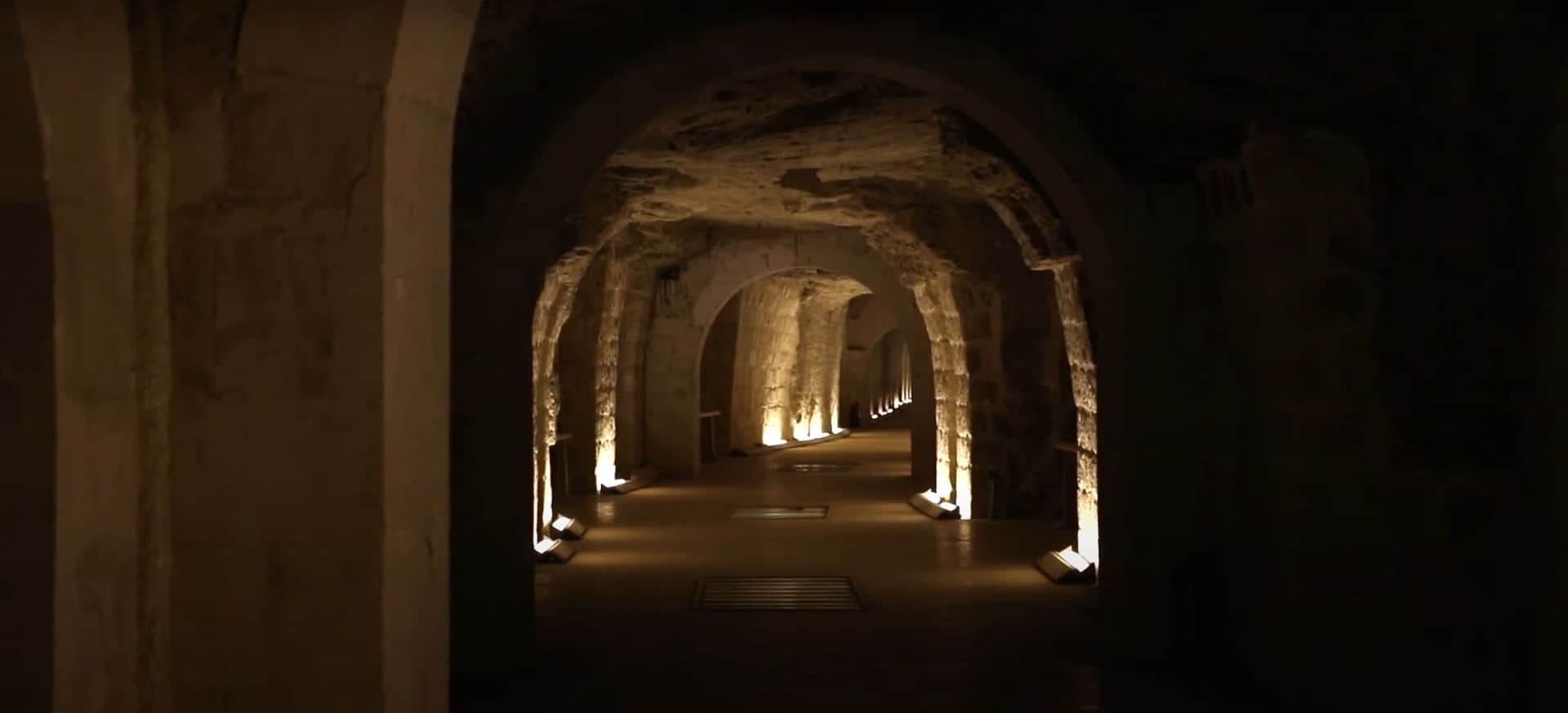Serapeum of Saqqara – Giza, Egypt

Updated On: March 03, 2024 by Ahmed Samir
Beneath the scorching sands of the Giza Plateau in Egypt, a hidden world of ancient mysteries and grandeur lies in wait, known to few and understood by even fewer. The Serapeum of Saqqara, an underground marvel concealed beneath the earth’s surface, is an enigma that has enthralled archaeologists, historians, and explorers for centuries. In this article, we embark on an extraordinary journey into the heart of Egypt’s past, where colossal granite sarcophagi, cryptic hieroglyphs, and age-old secrets await discovery.
The Serapeum is a testament to the genius of the ancient Egyptians, a gateway to understanding their religious devotion, and a riddle that continues to challenge our comprehension of their remarkable civilization. Join us as we delve deep into this labyrinthine sanctuary, seeking answers and uncovering the mysteries that have endured for millennia.
A Closer Look at the Serapeum of Saqqara
The Serapeum of Saqqara is an underground burial complex in the Saqqara necropolis, just south of Cairo, Egypt. It was primarily constructed during the reign of Pharaoh Seti I (1290-1279 BCE) of the 19th Dynasty, with additions made by his son, Ramesses II (1279-1213 BCE), and subsequent pharaohs. The name “Serapeum” is derived from Serapis, a Graeco-Egyptian deity who represented the fusion of Egyptian and Hellenistic religious traditions.
The primary purpose of the Serapeum of Saqqara was to serve as the final resting place for the sacred Apis bulls, revered as incarnations of the god Ptah and considered living deities by the ancient Egyptians. These bulls were carefully selected based on specific markings and were housed in a temple complex nearby during their lifetime. Upon their death, they were mummified and placed in grand granite sarcophagi within the Serapeum of Saqqara, where they were believed to undergo a spiritual journey to the afterlife.
The Architecture and Layout
The Serapeum of Saqqara is a marvel of ancient Egyptian engineering, featuring a series of long tunnels and chambers hewn into the solid rock beneath the plateau. The tunnels are flanked by large, rectangular alcoves that house the massive sarcophagi of the Apis bulls. These sarcophagi are carved from single blocks of rose granite, some weighing up to 70 tons. The precision with which these sarcophagi were cut and transported into the underground chambers is a testament to the advanced engineering skills of the ancient Egyptians.
The underground complex consists of several corridors and chambers, and it is divided into two main sections, known as the North and South galleries. The North gallery contains the sarcophagi from the time of Seti I and Ramesses II, while the South gallery houses the sarcophagi from later periods. The walls of these galleries are adorned with intricate hieroglyphs and religious inscriptions, providing insight into the religious beliefs and practices of the time.
The Enigma of the Sarcophagi
The most striking feature of the Serapeum of Saqqara is undoubtedly the massive granite sarcophagi that line its corridors. These sarcophagi, some measuring over 20 feet long, have puzzled researchers for centuries. The sheer size and weight of these stone coffins raise questions about how they were transported and placed in their final positions within the underground chambers.
One theory suggests that a combination of wooden sleds, water, and sand might have been used to transport the sarcophagi. The ancient Egyptians were known for their ingenious methods of moving heavy objects, and this theory posits that water was poured onto the sand in front of the sled, creating a slurry that reduced friction and allowed the sarcophagus to glide smoothly.
Another mystery surrounding the sarcophagi is their precise purpose. While it is clear that they were intended for the burial of the Apis bulls, some researchers believe that they may have held a more profound symbolic significance. The sarcophagi’s impeccable craftsmanship and monumental scale suggest that they were more than just burial containers; they may have been seen as vessels for the Apis bull’s journey to the afterlife or as symbols of divine power.
Religious Significance
The Apis bull, revered as an earthly manifestation of the god Ptah, held great religious significance in ancient Egypt. The cult of the Apis bull was intertwined with the worship of Ptah, the creator god and patron deity of craftsmen and architects. Ptah was believed to have created the world through thought and speech, and the Apis bull was seen as a symbol of his creative power.
The burial of the Apis bulls in the Serapeum of Saqqara was a highly ritualized process. The bulls were embalmed and placed in the granite sarcophagi with great reverence. The Serapeum was considered sacred, and priests conducted ceremonies and rituals to ensure the bulls’ safe passage into the afterlife.
The inscriptions on the walls of the Serapeum of Saqqara provide insight into the religious beliefs surrounding the Apis bull cult. They depict scenes of offerings, prayers, and rituals performed in honour of the sacred bulls. These inscriptions also contain the bulls’ names and the dates of their burials, allowing historians to trace the lineage of the Apis bull cult over centuries.
Theories and Mysteries
Despite extensive research and exploration, many aspects of the Serapeum remain shrouded in mystery. One of the most enduring questions is how to transport the colossal granite sarcophagi into the underground chambers. While the water and sand theory is plausible, it has yet to be definitively proven, and alternative methods are debated.
Another mystery surrounds the purpose of the complex’s intricate tunnels and chambers. Some researchers believe that the Serapeum may have served as a symbolic representation of the Egyptian underworld, with the sarcophagi symbolizing the boats that carried the deceased on their journey to the afterlife. Others suggest that the tunnels had a practical function, providing access for priests and workers responsible for maintaining the site.
Additionally, the Serapeum raises questions about the continuity and evolution of the Apis bull cult. The site contains sarcophagi from different periods, spanning centuries, reflecting the cult’s enduring significance. However, the rituals and beliefs associated with the Apis bull cult may have evolved, making it challenging for researchers to pinpoint the exact nature of these changes.
Attractions Near The Serapeum
Exploring the Giza Plateau allows visitors to immerse themselves in Egypt’s rich history and discover many other awe-inspiring attractions. Here are some of the notable sites and landmarks in proximity to The Serapeum:
- The Great Pyramids of Giza: Just a stone’s throw away from The Serapeum stand the world-famous Great Pyramids of Giza, including the Pyramid of Khufu (Cheops), the Pyramid of Khafre (Chephren), and the Pyramid of Menkaure. These colossal structures are among the most iconic and enduring symbols of ancient Egypt, and they continue to captivate the imagination of people worldwide.
- The Sphinx: Adjacent to the Great Pyramids, the Sphinx is a magnificent statue with the body of a lion and the head of a pharaoh, believed to represent Pharaoh Khafre. It is one of the world’s largest and oldest statues, exuding an air of mystery and ancient wisdom.
- Saqqara Necropolis: The Serapeum is part of the larger Saqqara Necropolis, which boasts an array of pyramids, tombs, and ancient structures. Notable attractions within Saqqara include the Step Pyramid of Djoser, the Pyramid of Unas, and the Pyramid of Teti. These monuments provide insight into the evolution of pyramid construction in ancient Egypt.
- Imhotep Museum: Named after the legendary architect and physician Imhotep, this museum is near the Step Pyramid of Djoser. It showcases a fascinating collection of artefacts, statues, and relics from the Saqqara necropolis, shedding light on the history and culture of the region.
- Memphis: The ancient city of Memphis, Egypt’s first capital, is near the Giza Plateau. While grander than it once was, visitors can explore the ruins and remnants of this historic city, including the colossal statue of Ramesses II and the Alabaster Sphinx.
- Giza Plateau Sound and Light Show: Experience the magic of the Giza Plateau after sunset with a captivating sound and light show. This multimedia spectacle narrates the history of the pyramids and the civilization that built them, providing an enchanting evening for visitors.
- Camel Rides and Desert Excursions: For a unique perspective of the Giza Plateau, consider taking a camel ride across the desert sands. These excursions offer an opportunity to enjoy the breathtaking landscape and take in the sheer magnitude of the ancient structures from a different angle.
- Giza Solar Boat Museum: Located near the Great Pyramid of Khufu, this museum houses the reconstructed Solar Boat of Khufu, a vessel believed to have been intended for the pharaoh’s journey in the afterlife. The intricately crafted boat and its significance in ancient Egyptian burial rituals make it a must-see attraction.
Visiting The Serapeum and its neighbouring treasures on the Giza Plateau is a journey through time and an immersion into the world of ancient Egypt. Whether you are an archaeology enthusiast, a history buff, or simply a traveller seeking to witness the wonders of antiquity, this region offers an unparalleled experience that leaves a lasting impression of wonder and reverence for past achievements.
Conclusion
The Serapeum of Saqqara is a testament to the ancient Egyptian civilization’s remarkable engineering prowess and deep religious beliefs. Its granite sarcophagi, colossal in scale and precision, continue to mystify and captivate archaeologists and historians. The site’s connection to the Apis bull cult and its role in ancient Egyptian religious practices shed light on these magnificent creatures’ cultural and spiritual significance.
As we continue to unravel the mysteries of the Serapeum, one thing remains clear – this subterranean complex holds the key to understanding a fascinating chapter in Egypt’s rich history. The enigmatic rituals, intricate inscriptions, and enduring reverence for the Apis bulls all contribute to the allure of this underground marvel. The Serapeum invites us to explore the intersection of ancient engineering, religious devotion, and spiritual belief, offering a glimpse into the depths of the past that continue to inspire wonder and curiosity today.
Additionally, the Serapeum raises questions about the continuity and evolution of the Apis bull cult. The site contains sarcophagi from different periods, spanning centuries, reflecting the cult’s enduring significance. However, the rituals and beliefs associated with the Apis bull cult may have evolved, making it challenging for researchers to pinpoint the exact nature of these changes.






